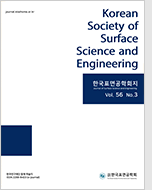
- Past Issues
- e-Submission
-

2021 Impact Factor 1.766
5-Year Impact Factor 1.674
Editorial Office
- +82-2-563-0935
- +82-2-558-2230
- submission@kssse.or.kr
- https://www.kssse.or.kr/

2021 Impact Factor 1.766
5-Year Impact Factor 1.674
The Korean Society of Surface Science and Engineering 2024;57(5):386-397. Published online: Nov, 5, 2024
DOI : https://doi.org/10.5695/JSSE.2024.57.5.386
Chrome plating is a method used to protect the inside of a gun barrel from the severe environment (3,000 K and 4,000 MPa for 20 ms) created by the propellant gas when a cannon is fired. However, Cr-plated films have physical limitations, and the formation of hexavalent Cr compounds has a harmful effect on the environment. Ta-W alloy film has been explored as an alternative to Cr plating owing to the high melting point and corrosion resistance of Ta. However, obtaining pure α-phase Ta by sputtering is difficult, and the autofrettage effect in gun barrels limits the use of annealing. Therefore, a deposition method without the use of additional heat treatment is required to prepare Ta-W films with alpha-phase Ta. We explored the feasibility of depositing Ta-W alloy film inside a 2,800 mm-long stainless-steel tube using bipolar high-power impulse magnetron sputtering. A specially designed cylindrical magnetron sputtering equipment and a four-stage experimental process was employed to deposit a coating with uniform thickness (10.59%) throughout the tube, high adhesive strength (51.51 MPa), and pure alpha-phase Ta. The findings of this study are useful for deposition of Ta-W alloy films inside large-caliber canons.
Keywords Cannon; Ta-W alloy; Cylindrical magnetron sputtering; Bipolar high-power impulse magnetron sputtering; Alpha phase; Thickness uniformity